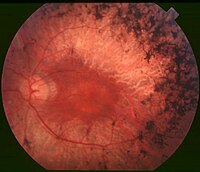
Photo from wikipedia
Imbalances in redox homeostasis can result in oxidative stress, which is implicated in various pathological conditions including the fatal neuromuscular disease Duchenne Muscular Dystrophy (DMD). DMD is a complicated disease,… Click to show full abstract
Imbalances in redox homeostasis can result in oxidative stress, which is implicated in various pathological conditions including the fatal neuromuscular disease Duchenne Muscular Dystrophy (DMD). DMD is a complicated disease, with many druggable targets at the cellular and molecular level including calcium-mediated muscle degeneration; mitochondrial dysfunction; oxidative stress; inflammation; insufficient muscle regeneration and dysregulated protein and organelle maintenance. Previous investigative therapeutics tended to isolate and focus on just one of these targets and, consequently, therapeutic activity has been limited. Nuclear erythroid 2-related factor 2 (Nrf2) is a transcription factor that upregulates many cytoprotective gene products in response to oxidants and other toxic stressors. Unlike other strategies, targeted Nrf2 activation has the potential to simultaneously modulate separate pathological features of DMD to amplify therapeutic benefits. Here, we review the literature providing theoretical context for targeting Nrf2 as a disease modifying treatment against DMD.
Journal Title: Redox Biology
Year Published: 2020
Link to full text (if available)
Share on Social Media: Sign Up to like & get
recommendations!